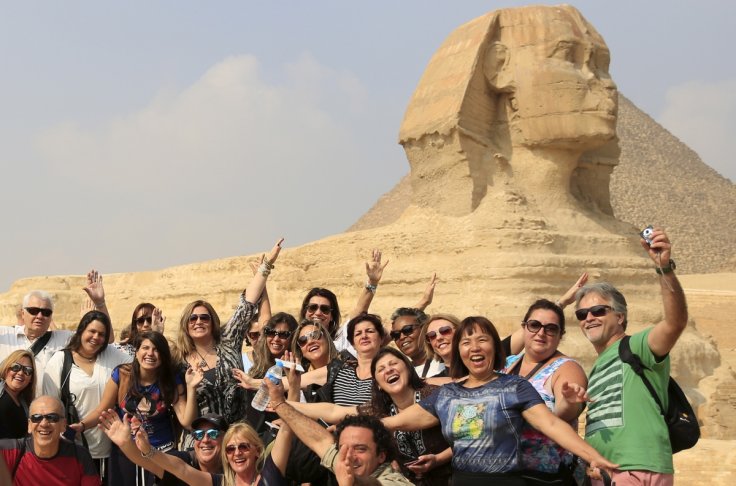On Saturday, May 2, Egyptian authorities announced that they have relocated four ancient sphinxes to the world-famous Tahrir Square in the heart of the capital city of Cairo, where they will join a huge 90-tonne pink granite obelisk from the period of Ramses II that was installed at the traffic-choked roundabout last year.
The historical town square that is also known as "Martyr Square" or "Liberation Square" is one of Cairo's most famous landmarks which came into world spotlight for being the location for the 2011 Egyptian Revolution that led to the ouster of the Hosni Mubarak regime. Along with this, Tahrir Square is also one of the busiest and most traffic-congested intersections in Cairo.
This has led to a rift between Egyptian archaeologists, or Egyptologists as they are commonly referred to, and officials from Egypt's antiques ministry, according to a report from The Guardian.
Transfer of ancient sphinxes to Tahrir Square

Egyptologists and other academicians have criticized the move, saying the transfer of the four ram-headed, sandstone sphinxes which were reportedly taken from the Karnak temple in the historical city of Luxor to the bust traffic roundabout of Tahrir Square will expose them to intense heat and the city's "notoriously high air pollution" which could damage the ancient artefacts.
The archaeologists are in the process of filing a lawsuit to stop the transfer of the sphinxes with the Egyptian courts, claiming that the move amounts to an "attempt to erase Egypt's ancient history." Meanwhile, the sphinxes will remain stored inside wooden crates until the official unveil, the date for which has not been confirmed yet.
Authorities say it will help attract tourists
"When we go to European capitals, like Rome or Paris or London, and also Washington, we see that they use Egyptian obelisks in decorating their major tourist squares, so why do we not do the same?," the local Al Ahram newspaper quoted Egypt's Minister of Antiquities, Khaled El-Enany as saying.
According to him, the pink granite Ramses II obelisk which was unearthed in the Nile Delta north of Cairo and moved to the square in 2019, will be mounted high to "give it the historical value" and attract tourists. Egyptian President Abdel Fattah El-Sisi, who rose to power in 2013 after a military coup, has reportedly defended the move to transfer the sphinxes, suggesting that obelisks and other artefacts have adorned central squared in Western cities, then why not in Cairo.
Egyptologist and academics have another theory
The Guardian cited Egyptologist, Monica Hanna who said the sphinxes were being endangered. "We oppose this because of concerns over the objects' safety in the pollution of Tahrir Square and the threat to the historical integrity of Karnak temple," she said.
Reportedly, a group of Egyptologist including an Egyptian Member of Parliament have filed a lawsuit against Minster of Antiquities, El-Enany and Egyptian Prime Minister, Mostafa Madbouly over the move.
Meanwhile, the relocation of the sphinxes has also been opposed by the Arab Regional Center for World Heritage, which is a part of the UNESCO, saying that uninstalling them from their original site was, in the very first place, against Egypt's commitment to preserving its heritage.
Tahrir Square's history
The world-famous Tahrir Square, which is one of Cairo's busiest traffic intersection, was the epicentre of the 2011 Arab Spring uprising in Egypt, where protesters gathered in the millions to protest the government of the country's late autocratic president Hosni Mubarak. Since then it became a place of mass gathering for millions of Egyptians who fought security forces for control of the city centre.
The square has been banned for protesters and is under heavy police surveillance since July 3, 2013, Egyptian coup d'etat, which saw the Egyptian military led by army chief General Abdel Fattah El-Sisi, overthrow the country's first elected Islamist President Mohamed Morsi, who came into power after the ouster of the Hosni Mubarak regime, amid mass protest against his rule.
A similar move to erect a memorial at the square to commemorate the almost 900 people who were killed during the 2011 uprising by the El-Sisi led government in 2013, attracted criticism and brought scorn from activists, who threatened to destroy the monument. Last year, a small group of protestors gathered at the square, triggering a full lockdown of the square and it's surrounding area by security forces, in a show of force to curb any further uprisings.
Move an effort to erase Tahrir Square's historical significance
Professor Rabab El Mahdi, who teaches political science at the American University in Cairo, said that monument represents the authorities' efforts to erase the country's contemporary history. "It covers over the recent memory that is alive in the minds of many people, with something historical that has no political connotations or significance," she was quoted as saying.
The installation of the obelisk and the sphinxes at Tahrir is supposedly being done to mask years of government efforts to remove traces of the 2011 uprising in downtown Cairo. Alternatively, all political murals and graffiti art have been erased in Tahrir Square and a parking lot is being built so that the entrance covers a corner of the square.
"It's basically no respect for the living who witnessed this revolution and see it as part of contemporary history, and no respect for the dead, including the antiquities," Mahdi added suggesting that the installing sphinxes and obelisk at Tahrir square was a bad idea.
Museum in Giza
Meanwhile, Egypt is also said to be building a new museum near the Pyramids in Giza to exhibit its Pharaonic heritage. The centrepiece of the collection in the museum is a towering statue of Ramses II, which once stood in another traffic square in central Cairo, next to Cairo's main railway station.








